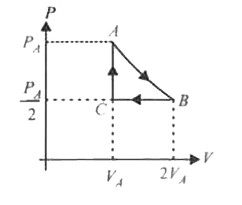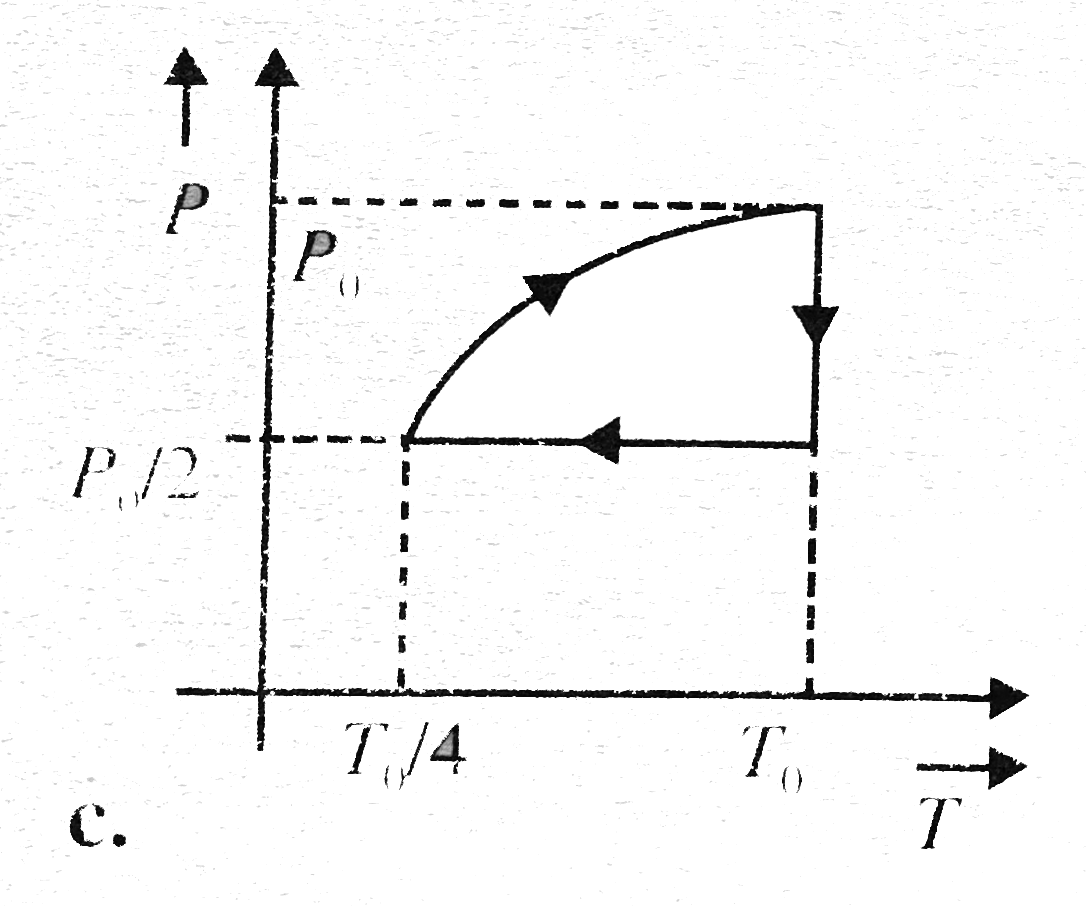A sample of an ideal gas has pressure p0, volume V0 and tempreture T0. It is isothermally expanded to twice its oringinal volume.it is then compressed at constant pressure to have the original volume V0. Finally, the gas is heated at constant volume to get the original tempreture.(a) show the process in a V-T diagram (b) calculate the heat absorbed in the process.
(a) The V-T diagram for the process is shown in . The initial state is represent by the point a. in the first step, it is isothermally expanded to a volume 2V(0). This is shown by ab. Then the pressure is kept constant and the gas is compressed to the volume to V(0). form the ideal gas equetion, V/T is constant att constant pressure. Hence, the oorigin. At point c, the volume is V(0). in the final step, the gas is heated at constant volume to a tempreture T(0). this is shown by ca. the final state is the same as the inital state.(b) the process is cycle so that the change in internal energy is zero.the heat supplied is, therefore, equel to the work done by the gas. the work done during ab is
W1=nRT0In2V0V0=nRT(0)In2=p(0)V(0)In2.
Also from the ideal gas equetion,
paVa=pbVb
paVa=pbVbVb=p0V02V0=p02
in the step bc, the pressusre remains constant hence, the work done is,
W2=p(0)2(V(0)−2V(0))=p0V02
in the step ca, the volume remains constant and so the work done is zero. the net work done by the gas in the cycle process is
W=W1+W2
=p(0)V(0)[In2−0.5]
=0.193p(0)V((0)).<br>hence,theheat⊃lied→thegasis0.193p_((0))V_((0)).

Topper's Solved these Questions
- LAWS OF THERMODYNAMICSBOOK - HC VERMACHAPTER - LAWS OF THERMODYNAMICSEXERCISE - Objective 1
9 Videos
- LAWS OF THERMODYNAMICSBOOK - HC VERMACHAPTER - LAWS OF THERMODYNAMICSEXERCISE - Objective 2
5 Videos
- LAWS OF THERMODYNAMICSBOOK - HC VERMACHAPTER - LAWS OF THERMODYNAMICSEXERCISE - Short Answer
15 Videos
- KINETIC THEORY OF GASESBOOK - HC VERMACHAPTER - KINETIC THEORY OF GASESEXERCISE - Exercises
62 Videos
- NEWTON'S LAWS OF MOTIONBOOK - HC VERMACHAPTER - NEWTON'S LAWS OF MOTIONEXERCISE - Exercises
42 Videos
Similar Questions
An ideal gas intially has pressure P volume V and temperature T. Its is isothermally expanded to four times of its original volume, then it is compressed at constant pressure to attain its original volume V. Finally, the gas is heated at constant volume to get the original temperature T. (a) Draw V−T curve (b) Calculate the total work done by the gas in the process.(given ln2=0.693)
View SolutionThree moles of an ideal gas (Cp=7/2R) at pressure pA and temperature TA is isothermally expanded to twice its initial volume. It is then composed at constant pressure to its original volume. Finally the gas is compressed at constant volume to its original pressure pA (i) Sketch p−V and p−T diagrams for the complete process (b) Calculate the net work done by the gas and net heat supplied to the gas a during the complete process.
View Solution
Knowledge Check
Three moles of an ideal gas Cp=7/2R at pressure PA and temperature TA is isothermally expanded to twice its initial volume. It is then compressed at constant pressure to its original volume. Finally the gas is compressed at constant volume to the original pressure PA.The correct P-V and P-T diagram indicating the process are
A B
B C
C D
D
One mole of an ideal gas at pressure P0 and temperature T0 is expanded isothermally to twice ist volume and then compressed at constant pressure to (V0/2) and the gas is brought bac to original state by a process in which PαV (pressure is direclty proportional to volume). The correct temperature of the process is
A B
B C
C D
D
A monatomic gas at pressure P1 and volume V1 is compressed adiabatically to 1(8)th of its original volume. What is the ginal pressure of the gas ?
A64P1BP1C16P1D32P1
Three moles of an ideal gas (Cp=72R) at pressure, PA and temperature TA is isothermally expanded to twice its initial volume. It is then compressed at constant pressure to its original volume. Finally gas is compressed at constant volume to its original pressure PA.
(a) Sketch P-V and P-T diagrams for the complete process.
(b) Calculate the net work done by the gas, and net heat supplied to the gas during the complete process.
View SolutionAn ideal gas has pressure p0, volumn V0 and temperature T0. It is taken an isochoric process till its pressure is doubled. It is now isothermally expanded to get the original pressure. Finally , the gas is isobarically compressed to its original volume V0. (a) Show the process on a p-V diagram. (b) What is the tempertaure in the isothermal part of the process? (c) What is the volumn at the end of the isothermal part of the process?
View SolutionThree moles of an ideal gas (Cp=72R) at pressure p0 and temperature T0 is isothermally expanded to twice its initial volume. It is then compressed at a constant pressure to its original volume.
(a) Sketch p-V and p-T diagram for complete process.
(b) Calculate net work done by the gas.
(c) Calculate net heat supplied to the gas during complete process.
(Write your answer in terms of gas constant =R)
View SolutionAn ideal gas has volumeV0 at . 27∘C It is heated at constant pressure so that its volume becomes . 2V0.The final temperature is
View SolutionA monoatomic gas at pressure P1 and volume V1 is compressed adiabatically to 18th of its original volume. What is the final pressure of gas.
View Solution
